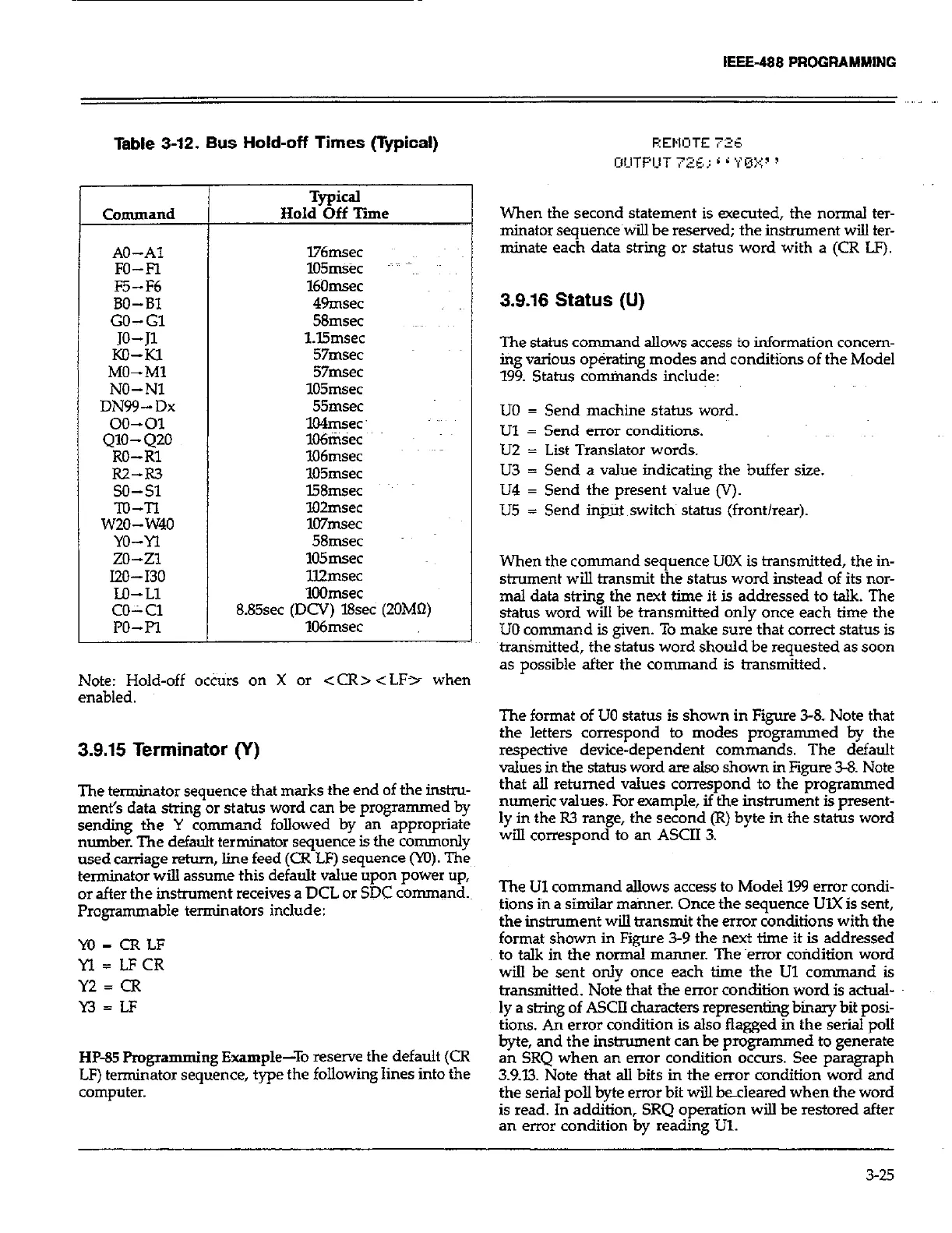EE-488 PROGRAMMING
Table 3-12. Bus Hold-off Times (Typical)
Command
AO-Al
FO-Fl
F5-F6
BO-81
GO-G1
JO-P
K&K1
MO-Ml
NO-N1
DN99- Dx
00-01
QlO-Q20
RO-Rl
IQ-R3
so-s1
m-n
W20-W40
YO-M
zo-Zl
I20-I30
Lo-L1
co- Cl
PO-p1
Typical
Hold Off Time
l76msec
105msec ~~ _ ~-~
16omsec
49msec
58msec
lJ5msec
57msec
57msec
105llW.X
55msec
104msec’
lffimsec
106msec
105msec
l58msec
lO2msec
lU7llISW
58msec
105msec
lmnsec
1OOmsec
8.85s~~ (DCV) l8sec (ZOMQ)
106msec
Note: Hold-off ocCurs on X or <CR> <LF-> when
enabled.
3.9.15 Terminator (Y)
The terminator sequence that marks the end of the in&u-
merit’s data shing or status word can be programmed by
sending the Y command followed by an appropriate
number. The default terminator sequence is the commonly
used carriage return, line feed (CR LF) sequence (YU). The
terminator will assume this default value upon power up,
or after the instrument receives a DCL or SDC command.~
Programmable terminators include:
YO=CRLF
Yl = LFCR
Y2 = CR
YJ=LF
HP-85 Programming Example-To reserve the default (CR
LF) terminator sequence, type the following lines into the
computer.
When the second statement is executed, the normal ter-
minator sequence~tiill be reserved; the instrument will ter-
minate each data string or status word with a (CR LF).
3.9.16 Status (U)
The status comman d allows access to information concern-
ing various operating modes and conditions of the Model
199. Status commands include:
UO = Send machine status word.
Ul = Send error conditions.
U2 = List Translator words.
U3 = Send a value indicating the buffer size.
U4 = Send the present value (V).
U5 = Send input switch~ stahw (front/rear).
When the command sequence UOX is transmitted, the in-
strument will transmit the stahz word instead of its nor-
mal data string the next time it is addressed to talk. The
status word will be transmitted only once each time the
UO command is given. To make sure that correct status is
transmitted, the status word should be requested as soon
as possible after the command is transmitted.
The format of UO status is shown in Figure 3-8. Note that
the letters correspond to modes programmed by the
respective device-dependent commands. The default
values in the status word are also shown in Figure 3-8. Note
that all returned values correspond to the programmed
numeric values. For example, if the instrument is present-
ly in the R3 range, the second (R) byte in the status word
will correspond to an ASCII 3.
The Ul command allows access to Model 199 error condi-
tions in a similar maimer. Once the sequence UIX is sent,
the instrument will &xwn.it the error conditions with the
format shown in Figure 3-9 the next time it is addressed
to talk in the normal manner. The terror condition word
will be sent only once each time the Ul command is
transmitted. Note that the error condition word is a&ml-
ly a string of ASCII characters representing biiszy bit posi-
tions. An error co~ndition is also flagged in the serial poll
byte, and the instrument can be programmed to generate
an SRQ when an error condition occurs. See paragraph
3.9.13. Note that all bits in the error condition word and
the serial poll byte error bit will becleared when the word
is read. In addition, SRQ operation will be restored after
an error condition by reading Ul.
3-25
